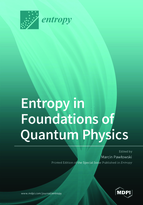Entropy in Foundations of Quantum Physics
A special issue of Entropy (ISSN 1099-4300). This special issue belongs to the section "Quantum Information".
Deadline for manuscript submissions: closed (31 May 2019) | Viewed by 58950
Special Issue Editor
Special Issue Information
Dear Colleagues,
Recently, the interest in foundational research in physics has been rekindled, mostly due to the advances of quantum information. Not only does it provide versatile tools, but also ways to link this field with practical applications. Probably, the best example of such a connection is Ekert’s cryptographic protocol from 1991.
Since entropy can be used, among other things, to measure uncertainty and information capacity, it has been widely used in that field. Some of its applications include Bell inequalities, nonlocality, causal structures, system complexity and uncertainty relations. Moreover, presence of entropy in other areas of research allows it to become a bridge between foundations and these fields.
Current trends seem to indicate that the role of entropy in the studies of the foundations of quantum physics will only increase and lead to many new exciting discoveries. I, therefore, encourage you to submit your work to this Special Issue.
Dr. Marcin PawłowskiGuest Editor
Manuscript Submission Information
Manuscripts should be submitted online at www.mdpi.com by registering and logging in to this website. Once you are registered, click here to go to the submission form. Manuscripts can be submitted until the deadline. All submissions that pass pre-check are peer-reviewed. Accepted papers will be published continuously in the journal (as soon as accepted) and will be listed together on the special issue website. Research articles, review articles as well as short communications are invited. For planned papers, a title and short abstract (about 100 words) can be sent to the Editorial Office for announcement on this website.
Submitted manuscripts should not have been published previously, nor be under consideration for publication elsewhere (except conference proceedings papers). All manuscripts are thoroughly refereed through a single-blind peer-review process. A guide for authors and other relevant information for submission of manuscripts is available on the Instructions for Authors page. Entropy is an international peer-reviewed open access monthly journal published by MDPI.
Please visit the Instructions for Authors page before submitting a manuscript. The Article Processing Charge (APC) for publication in this open access journal is 2600 CHF (Swiss Francs). Submitted papers should be well formatted and use good English. Authors may use MDPI's English editing service prior to publication or during author revisions.
Keywords
- Entropy
- Uncertainty relations
- Information causality
- Bell inequalities
- Causal structures
- Axioms of quantum mechanics
- Nonlocality
- Contextuality
Benefits of Publishing in a Special Issue
- Ease of navigation: Grouping papers by topic helps scholars navigate broad scope journals more efficiently.
- Greater discoverability: Special Issues support the reach and impact of scientific research. Articles in Special Issues are more discoverable and cited more frequently.
- Expansion of research network: Special Issues facilitate connections among authors, fostering scientific collaborations.
- External promotion: Articles in Special Issues are often promoted through the journal's social media, increasing their visibility.
- e-Book format: Special Issues with more than 10 articles can be published as dedicated e-books, ensuring wide and rapid dissemination.
Further information on MDPI's Special Issue polices can be found here.







